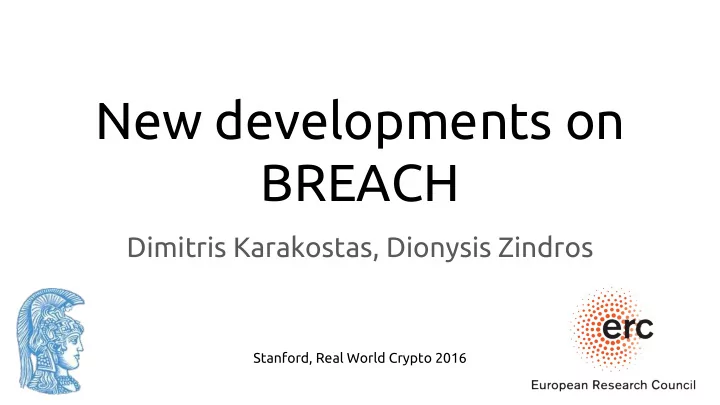

New developments on BREACH Dimitris Karakostas, Dionysis Zindros Stanford, Real World Crypto 2016
Overview ● BREACH review Our contributions ● Statistical attacks ● ● Attacking block ciphers ● Attacking noise Optimization techniques ● Mitigation recommendations ●
Original BREACH research Angelo Prado Neal Harris Yoel Gluck
BREACH Introduced in Black Hat USA 2013 Paper: http://breachattack.com/resources/BREACH%20-%20SSL,%20gone%20in% 2030%20seconds.pdf
Original BREACH ● Compression/encryption attack similar to CRIME Based on length-leak ● Targets HTTPS response ● ● Works against stream ciphers ● Decrypts HTTPS secrets in 30 seconds
Original BREACH assumptions Adversary: Controls the network (ARP spoofing, DNS poisoning, etc.) ● Victim client: Runs Javascript with same-origin policy ● ● Visits HTTP websites or clicks an adversary link
Original BREACH assumptions Victim server: Uses HTTPS (with HSTS) ● ● Compresses response using gzip (Huffman + LZ77) ● Uses stream cipher (RC4) Response has limited noise ● Contains end-point that reflects URL parameter ●
Original BREACH target ● Steal secret in HTTPS response CSRF tokens ● Impersonate victim client to victim server ●
BREACH attack anatomy
Length leaks |E(A)| < |E(B)| ⇔ |A| < |B|
Reflection Noise Secret
Reflection matches secret suffix Secret suffix
Original BREACH methodology ● Guess part of secret and insert into reflection Match ? → Shorter length due to LZ77 compression ● No match ? → Longer length ● ● Bootstrap by guessing 3-byte sequence ● Extend with hill-climbing one character at a time Correct character minimizes length ● Huffman is avoided with fix point methods ● ● O(n|Σ|) complexity n : length of secret ○ ○ Σ : alphabet of secret ● Still not mitigated!
Our contributions
Our contributions We extend the BREACH attack 1. Attack noisy end-points 2. Attack block cipher end-points 3. Optimize attack through parallelization 4. Propose novel mitigation techniques
Statistical methods
Statistical methods ● Our methods work against noisy end-points We perform multiple requests per alphabet symbol ● Take the mean response length ● ● Given m -sized noise, basic attack works in O(n|Σ|√ m ) m = (maximum response size) - (minimum response size) ○ Allows attacking noisy end-points ● ● Length converges to correct results
Statistical attack against popular web service
Statistical methods against block ciphers ● Most services use block ciphers Original attack did not target block ciphers ● Our method successfully attacks block ciphers ● ● We introduce artificial noise ● Block ciphers round the length to 128-bits (VS 8-bit in stream ciphers) Statistical methods are used to obtain plaintext ● In practice 16x more requests ● ● Better results are achievable using block alignment techniques
Experimental results ● AES_128 is vulnerable Popular web services are vulnerable ●
Optimizations
Optimizations Parallelize! Each request can try multiple candidates from the alphabet ● ● Partition the alphabet using a divide-and-conquer scheme ● Binary search using alphabet partitions We reduce the attack complexity from O(n|Σ|) to O(n lg|Σ|) ● Practically this can give an 8x speed-up ● ● This counter-balances the noise and block cipher slowdowns
Binary search in alphabet space { 0, 1, 2, 3, 4, 5, 6, 7, 8, 9 } { 5, 6, 7, 8, 9 } { 0, 1, 2, 3, 4 } { 3, 4 } { 0, 1, 2 } { 4 } { 3 }
Parallelization distinguishability in popular service
Mitigation
Mitigation: Extend CSP for same-origin cookies ● Authentication cookies should not be sent in cross-origin request Opt-in mechanism for backwards compatibility: CSP cookie headers ● Allow web authors to specify if a cookie is to be treated as same-origin-only ● ● We are in touch with W3C webappsec to support this option ● Requires adoption by web authors and browser vendors Content-Security-Policy: cookie-scope ‘sessionid’ same-origin;
What’s next? ● Come see us at Black Hat Asia 2016 in Singapore for demos We are working on open source BREACH tools which we will be releasing ●
Thanks! @dionyziz 45DC 00AE FDDF 5D5C B988 EC86 2DA4 50F3 AFB0 46C7
Recommend
More recommend